Since 2005, one of the primary means of public transportation for commuters in the San Fernando Valley has been the Metro Orange Line, a bus rapid-transit network of exclusive busways along the East-West Transit Corridor. On average, there are 31,787 weekday travelers at the stops between Chatsworth and North Hollywood. Calling the Orange Line crowded is an understatement – ridership is actually more than double the initial capacity estimates. During rush hours, Orange Line buses are often too crowded for new passengers at many stops, requiring potential riders to wait extended periods or take alternative modes of transportation. Along with ridership growth, automobile and foot traffic is steadily increasing as the Valley population grows. This additional traffic is causing Orange Line buses to be delayed, leading to unreliability for riders to reach Valley businesses. Unfortunately, many consider the overcrowding and delays to be normal consequences of public transportation. But the Valley Industry and Commerce Association (VICA) has consistently pushed to change the public transportation options in the Valley. In particular, VICA has advocated for a light rail transit system similar to the Gold Line running from East Los Angeles to Pasadena. But for that to happen, legislators must repeal Senate Bill 211, a 22-year-old bill that limits any rail transit project along what is now the Orange Line route to only underground heavy rail transit systems, similar to the Metro Red Line. The bill was passed by former Sen. Alan Robbins in response to a vocal minority that opposed light rail along Chandler Boulevard in the North Hollywood area. But heavy rail transit was considered too costly, and so the bus system was developed instead. One group’s demands managed to block the entire Valley from getting a light rail system. It is time to open up the discussion again. When 60 percent of all public transportation users are commuting to and from their work – and usually during rush hour – then capacity is the most important factor. Light rail transit is the most economically efficient option, with significantly higher ridership potential than buses and lower cost than underground subways. Bus capacity is the lowest of the three modes and does not provide economic redevelopment opportunities compared to rail lines. Additionally, a 2007 study from the Journal of Public Transportation estimated that the baseline end-to-end travel time for the Orange Line is 42 minutes, while a light rail system would travel end-to-end in 29 minutes – a 30 percent difference. The ultimate solution to the Valley’s public transportation woes is a light rail system, and that starts with the repeal of Robbins’ bill. With that hurdle out of the way, the region can begin considering funding and development options. VICA has publicly pushed for the repeal of SB 211 and encourages you to contact your legislators to make this a priority for 2013. The county needs to have the legal capability to replace the Orange Line bus system with a light rail system if it wants to accommodate the commuter needs of the Valley. The Valley Industry and Commerce Association (VICA) is a business advocacy organization based in Sherman Oaks that represents employers throughout the Los Angeles County region at the local, state and federal levels of government.
